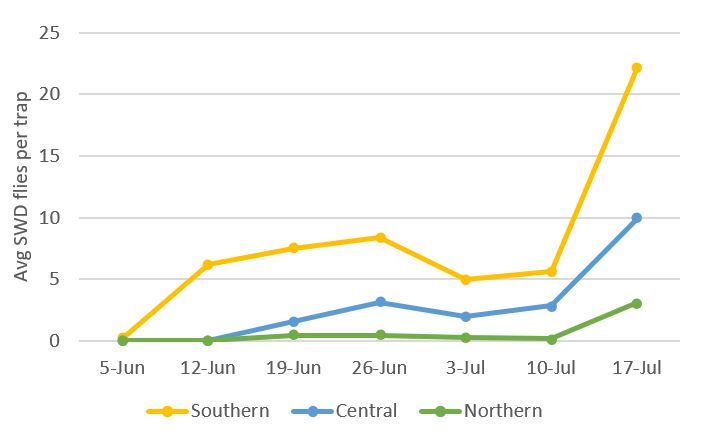Michigan spotted wing Drosophila update – July 21, 2020
Spotted wing Drosophila populations have begun to surge. Growers must protect susceptible crops.

This year, Michigan State University Extension is monitoring for spotted wing Drosophila (SWD) activity in 17 counties (Figure 1) at over 90 sites that include vineyards, sweet and tart cherry orchards, and blueberry, raspberry and strawberry plantings. This report is the fifth of the season, and week seven of our monitoring efforts.
Conditions have been favorable for a rise in SWD populations this week (Figure 2). Rain events, humid weather, temperatures hovering at or below 90 degrees Fahrenheit, and wild hosts like honeysuckle ripening in field margins are all resulting in higher numbers of SWD than previous weeks. Unprotected blocks of ripening berries are at high risk of infestation by SWD larvae.

Berries
Ripening blueberries and summer raspberries should be protected against infestation as populations of SWD begin to surge. Other thin-skinned berries susceptible as they ripen to SWD infestation include currants, gooseberries, blackberries and saskatoons. For U-pick operations, following up with removal of overripe berries left behind is an essential sanitation practice to reduce local SWD pressure. For other tips on fruit waste management, tune in on July 24 to the SWD Friday webinar series.
Cherries
Cherry harvest is finished in most of Michigan and this is the last week we will be monitoring for SWD in cherry orchards. Any unprotected cherries remaining are at high risk of infestation. This season we explored the use of fruit phenology to help predict when cherries may be at low, medium, or high risk of infestation by SWD. The model, which we have been working towards validating this season, is based on the assumption that cherry ripening will occur between 954 to 1170 growing degree days (GDD) base 39.2 F post bloom and that SWD flies have been caught in the area. In the next SWD Friday webinar series on July 24, we will discuss how the model worked this season.
Grapes
Grapes are not at a susceptible stage anywhere in the state at this time. Details on how to manage SWD and other vinegar flies to minimize their role in sour rot in grapes will be presented during the SWD Friday webinar series on Aug. 14.
Managing SWD
Given how quickly this pest can reproduce and how devastating infestation can be, if your crop is at a susceptible stage, a cover spray of an insecticide that is rated excellent against this pest should be applied to protect fruit. Remember to rotate insecticide classes once you begin your spray program. Also, keep in mind that some classes of insecticides wash off after rain events or when using overhead irrigation more readily than others or will be less effective under high heat conditions (e.g., some pyrethroids).
Most of the crop-specific management guides have been updated for the 2020 season and are available as free downloadable PDFs, including a guide for home gardens. For more information on effective insecticides registered for use to control SWD, refer to the MSU Extension Michigan Fruit Management Guide (E154).
Sampling fruit for SWD infestation
Growers can determine how well their program is working by sampling fruit and using the salt test in the days prior to harvest. At this point in the season, this provides much more useful information than catches of flies in traps, so we recommend berry growers to switch to salt testing to understand their risk of infestation (and to document that fruit are clean of any infestation by SWD). For details on the filter method described during the SWD Friday webinar series on July 10, check out this open-access article, “A Filter Method for Improved Monitoring of Drosophila suzukii (Diptera: Drosophilidae) Larvae in Fruit.”
Monitoring for SWD on your farm
The deli cup style trap is still the standard and can be used with either a commercial lure or a homemade yeast and sugar bait. For more information on how to monitor for SWD, refer to the crop management guides on the MSU Spotted Wing Drosophila website. For help with distinguishing SWD from all the other small flies that may be caught in SWD traps, refresh your identification skills with the Spotted Wing Drosophila Identification Guide from MSU.
Counties being monitored in 2020: Allegan, Berrien, Genesee, Ingham, Livingston, Macomb, and Van Buren in the south, Ionia, Kent, Mason, Oceana, and Ottawa in central Michigan, and Antrim, Benzie, Grand Traverse, Leelanau, and Manistee in the north.



 Print
Print Email
Email
